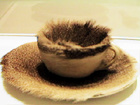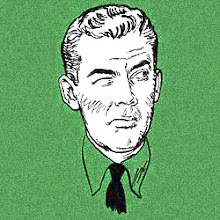 Born in Scotland, she came to the U.S. in 1939. Aside from writing her poetry, she did various odd jobs--was for a time an actress, and appeared in Death and Our Corpses Speak (both produced in Germany); these were made by experimental film-maker Rosa von Prauhnehim. Her last public appearance was in the public TV series Poetry Minute in 1988. She became a recluse after her sister died that year and herself died in '93.
Born in Scotland, she came to the U.S. in 1939. Aside from writing her poetry, she did various odd jobs--was for a time an actress, and appeared in Death and Our Corpses Speak (both produced in Germany); these were made by experimental film-maker Rosa von Prauhnehim. Her last public appearance was in the public TV series Poetry Minute in 1988. She became a recluse after her sister died that year and herself died in '93.Her book Ballads was published by White Rabbit in 1961.
Although her mode was the classical ballad, she was nonetheless closely associated with the Beats and others in the San Francisco school. Kristen Prevallet has written about Adams in an essay called "The Worm Queen Emerges: Helen Adam and the Forgotten Ballad Tradition" (for a book called Girls Who Wore Black: Women Writing the Beat Generation, 2002). She is also featured in several pages of Michael Davidson's The San Francisco Renaissance. "Although Adam revives a much earlier ballad tradition," Davidson writes, "she often transforms it to suit contemporary political and society reality."
I drank milk, Mother, in my sheltered home.
I drank milk, and I ate honey-comb.
Now I'm eating goof balls, drinking rum and gall,
wine, and gine, and vodka, and wood alcohol.
Give me ten Tequilas, a jigger full of stout,
And a little lap of Pepsi before I freak out
In the reeling Jericho Bar.
In its tone and in the way it manages the daring content, the poem reminds me of Elsa von Freytag Loringhoven's "A Dozen Cocktails--Please". But of course the Baroness wrote utterly in free form.

 Is '60 the moment when the end of the end of the Old Left had been reached and the New Left began to emerge? Is it the final ascendancy, in certain scenes at least, of poetic postmodernity? Surely the publication of Donald Allen's The New American Poetry that year suggests this, but then again--once again--we look back on "New" here and see continuity. The rhetoric of the Kennedy-Nixon contest made much less of a dent than everyone (at the time as well as since) claimed, so one wonders why were such great claims made?
Is '60 the moment when the end of the end of the Old Left had been reached and the New Left began to emerge? Is it the final ascendancy, in certain scenes at least, of poetic postmodernity? Surely the publication of Donald Allen's The New American Poetry that year suggests this, but then again--once again--we look back on "New" here and see continuity. The rhetoric of the Kennedy-Nixon contest made much less of a dent than everyone (at the time as well as since) claimed, so one wonders why were such great claims made?  Had we come to expect "1960" to be truly ubiquitously modern in a way that the 1950s really were not--not quite? And what specifically does "modern" mean in the Kennedyesque talk then and now about the torch being passed to a new generation, etc.? The First Lady really meant "modernist" when Camelotians said "modern." What about the others across the new young cultural leadership? I've been surprised by how frequently the
Had we come to expect "1960" to be truly ubiquitously modern in a way that the 1950s really were not--not quite? And what specifically does "modern" mean in the Kennedyesque talk then and now about the torch being passed to a new generation, etc.? The First Lady really meant "modernist" when Camelotians said "modern." What about the others across the new young cultural leadership? I've been surprised by how frequently the  "Beat movement" was covered in 1960 in the mainstream press. I was expecting a fair measure but I've found tonnage. 1960 was the year when the figure of the beat was beginning to find acceptance, although still 80% of these stories are mocking, rebels-without-cause condescension. For anyone whose analysis made an impact nationally, do these antipolitical adolescents count as part of the "new young cultural leadership"? No, but rather than the two being opposites, they fall along a Continuum of the New American. Now that's a change for '60.
"Beat movement" was covered in 1960 in the mainstream press. I was expecting a fair measure but I've found tonnage. 1960 was the year when the figure of the beat was beginning to find acceptance, although still 80% of these stories are mocking, rebels-without-cause condescension. For anyone whose analysis made an impact nationally, do these antipolitical adolescents count as part of the "new young cultural leadership"? No, but rather than the two being opposites, they fall along a Continuum of the New American. Now that's a change for '60.







